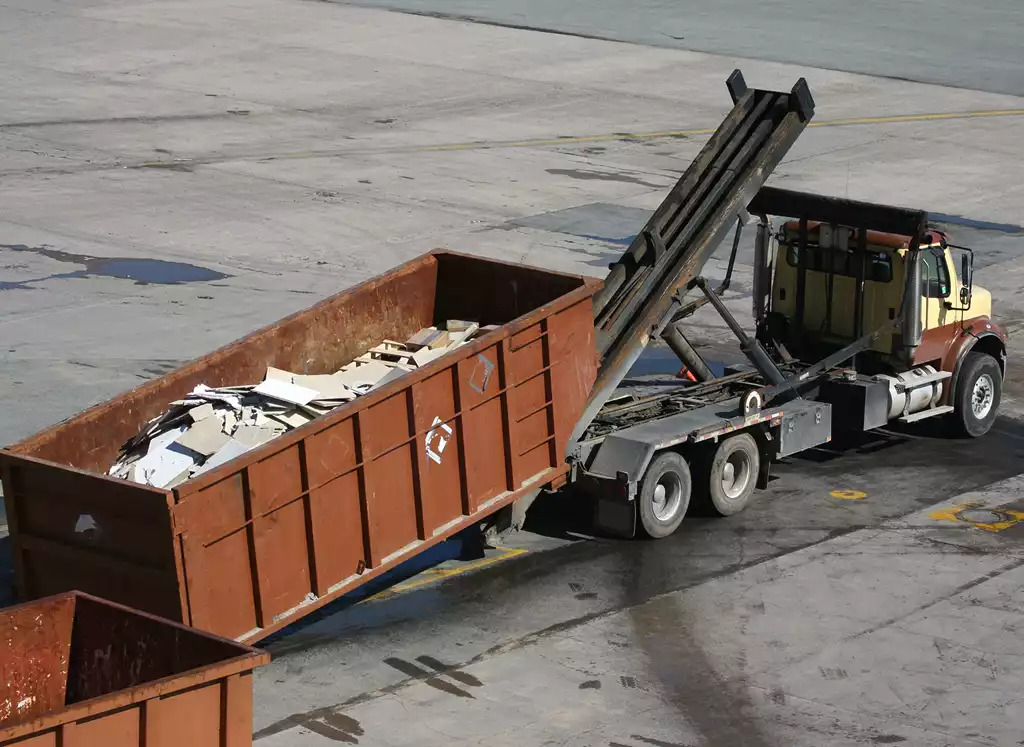Dumpsters may not be the most attractive component of a project, but their existence is undoubtedly important at the job site. You can see dumpsters all around commercial buildings and construction sites. Whereas, the effectiveness of your project and the reduction of expenses can both be considerably impacted by proper trash management and recycling. Because proper disposal of waste is also advantageous for the environment in addition to your project. Let’s see how many types of dumpsters are available in the market that may fit your job requirements.
-
Roll-Off Dumpster
Roll-off dumpsters, which are famous for their adaptability and ease of use, are the productive machines of construction sites. These construction equipment for sale are available in various sizes, ranging from 10 to 40 yards. Since they are easy to roll on and off of a customized trailer, their distinctive distribution mechanism is where the term “roll-off” originates.
It takes a hydraulic lift mechanism to empty a roll-off dumpster. A winch and sledge or a robotic arm can be useful to load these dumpsters back onto the truck. Large-scale cleanups, home renovation projects, and landscaping jobs are especially well suited for roll-off dumpsters. They are perfect for moving heavy objects like refrigerators, bricks, trees, and roofing materials thanks to their large capacity.
Quick Features:
- Sizes between 10 and 40 cubic yards.
- Designed for simple delivery and removal on-site
- Emptied with the use of a hydraulic lift system.
- Winch and sledge and robotic arms are two possibilities for loading
- Ideal for moving hefty objects like stones, trees, roofing materials, and appliances
-
Front-Load Dumpster
One of the two primary varieties of commercial dumpsters is the front loader. These trash bins, which are typically suitable in residential and commercial sites with a sizable amount of disposable waste, range in size from 2 to 8 cubic yards.
These bins are smaller, rectangular in design, and have a top lid that is one-sided and hinged. They are inserted into slots on either side of the bin by garbage trucks with specialized spikes. The truck can then raise the bin and empty its contents into its hopper with the help of this. Front-load dumpsters are perfect for areas producing smaller, lighter waste because of their shape, which makes it simple to drop waste into the top section.
Quick Features:
- Compact, rectangular design with a slanted, hinged lid
- Size ranging from 2 to 8 cubic yards
- Garbage trucks with elevating spikes designed for them
- Appropriate for areas producing smaller, lighter waste
- Simple access to the top area for dumping waste
-
Rear-Load Dumpster
The other primary variety of commercial dumpsters, rear load dumpsters, are comparable to front load dumpsters but differ significantly from them. These dumpsters range in size from 2 to 8 cubic yards. The design is functional and easy to empty from the back of the garbage truck.
Rear-load dumpsters feature a sloping back as opposed to a slanted top, unlike front-load dumpsters. A hinge system and winch are available in them to empty the trash from them. The dumpster stands to the back of the garbage truck by two poles, and the winch elevates the dumpster until the trash is fully empty into the hopper of the truck. Due to its greater height and length, rear-load dumpsters are more suited for confined places. They are suitable for small companies, home improvements, and other similar settings.
Quick Features:
- Load capacities vary from 2 to 8 cubic yards
- Slanted rear design for simple loading from the back
- Winch and hinge method for draining
- The garbage truck and dumpster are connected by two poles.
- Suitable for smaller rooms.
-
Construction Dumpster
Roll-away dumpsters, usually referred to as construction dumpsters, are suitable for disposing of bigger amounts of construction-related debris. For simple transport, they have wheels on the bottom. These dumpsters are adaptable enough to tackle a variety of building activities because they come in sizes ranging from 10 to 40 cubic yards.
Construction dumpsters stand out due to their versatility in terms of the number of debris they can hold. While some versions are useful to carry heavy-duty materials like concrete, stones, and asphalt, others are suitable to carry exclusively yard debris and dirt. To manage the specific garbage produced by your project, selecting the appropriate construction dumpster is essential.
Quick Features:
- Sizes range between 10 and 40 cubic yards.
- Equipped with wheels for convenient on-site transportation
- Specialized variants created for various trash kinds
- Ability to work with heavy-duty materials like concrete, stones, and asphalt
- Ideal for building remodelling, demolition, and landscaping
-
Footnote
Whether it is a major construction project or a little home remodel, efficient waste management is a key component of any successful operation. For streamlined operations and budget-conscious pricing, it is important to know about the many dumpster kinds and make an informed decision. With the proper dumpster in place, you can properly manage waste, maintain the cleanliness of your building site, and contribute to a construction process that is more ecologically friendly and sustainable.


